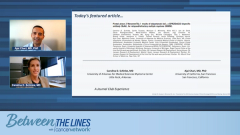
Long-Term Followup With Talquetamab in Relapsed/Refractory MM: Infection Rates
Expert hematologist-oncologists identify long-term data from MonumenTAL-1 regarding infection rates in patients with relapsed/refractory multiple myeloma.
Episodes in this series

Transcript:
Ajai Chari, MD, PhD: The other thing I wanted to ask you about, which is I think perhaps one of the most interesting things, is because these data are similar to what’s been presented at prior meetings. I think one of the main updates is 2 things. Number one, and it sets up some of our future abstracts that we’re going to talk about. One is that with now 18-month follow-up in cohort 1, the rates of infection are still hovering under 20%. And I’m curious to hear your thoughts on that. Also the lack of nonprogressive deaths because I think one of the concerns with some of the other BCMA bispecifics, for example, is these infectious deaths. So what are your thoughts about this longer-term follow-up? Are you reassured about the infection profile of this agent?
Carolina D. Schinke, MD: I think in terms of infections from our experience, the patients that we enrolled, we really had no major problems at all. Obviously part of the study was also done during COVID. So one, 2 patients got COVID, would have probably gotten COVID anyway, and 1 got very sick. Apart from that, I think really it’s the degree of neutropenia, leukopenia, lymphopenia that you see in these BCMA-targeting bispecifics, we don’t see that. And what we see is neutropenia has been reported even in talquetamab, but it’s just transitioned, it’s just usually during the first cycles. Then it kind of goes back to more normal levels. Hypogammaglobulinemia, which is very profound in these BCMA-targeting bispecific antibodies, is by far not that bad or we don’t see it to that degree in GPRC5D or in the talquetamab. Obviously, a lot of patients are hypogammaglobulinemia at a relapse/refractory stage. Nonetheless, the IgG level would just be below 600 or even below 500, but we don’t see it dropping severely more. Which we see with BCMA-targeting bispecifics; their levels can go drastically down. And the degree of immunosuppression you see with the talquetamab is as severe and as bad as we see with the BCMA-targeting bispecifics. Hence the infectious rate is also, again, from our experience not as bad as all, not as bad as what has been reported for BCMA-targeting bispecifics.
Ajai Chari, MD, PhD: I really agree with those comments. There was actually an ASCO [American Society of Clinical Oncology] presentation as well looking at the humeral and immune profile of talquetamab, showing that there’s actually recovery of B cells and even potential recovery of immunoglobulins. This is completely the opposite of BCMA bispecifics, where the repetitive targeting of BCMA, and we think perhaps this is because of the dirtiness of the antigen, that maybe GPRC is more preferentially expressed on malignant plasma cells and maybe sparing the B-cell compartment in normal plasma cells. Whereas BCMA may be a little dirtier, and that may be why. I think just for the listeners, with the 14-month follow-up with teclistamab, which is the longest follow-up of the BCMAs that we have, the rates of grade 3 and 4 neutropenia were over 60%. And the rate of grade 3, 4 infections and grade 3-plus infections was actually about 45%. And so that’s almost double, more than double what we’re seeing with talquetamab. I think these AEs [adverse effects] are essential to the future, which is combination of strategies, of course.
Transcript edited for clarity.
Newsletter
Stay up to date on recent advances in the multidisciplinary approach to cancer.

















































































